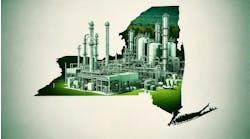Jeremy Rifkin, an economist and social theorist, envisaged in his book, The Hydrogen Economy, a worldwide hydrogen energy web as an answer to peak oil and as a way to democratize global energy. How well has Rifkin’s vision fared in the 20 years since it was first published in 2002? And how does this affect the process industries?
Concerns about peak oil and gas have receded with the advent of fracking. However, the quest for decarbonization has spurred increasing attention on hydrogen, because when pure hydrogen burns, it does not produce any carbon dioxide — only water. ( see “Drive Energy Efficiency with Decarbonization.”) However, this is only part of the story.
Today, most hydrogen is used in oil refining and chemical processing as a chemical reagent, not as a fuel. Emerging energy uses include transportation (fuel cell vehicles, such as cars, trucks, and trains, and possibly ships and airplanes); domestic, commercial, and industrial heating and power generation; and grid-scale energy storage.
In the International Energy Agency’s Sustainable Development Scenario, global hydrogen demand increases by a factor of more than seven, from 71 Mt/year in 2019 to 520 Mt/year in 2070. At this point, it would represent about 15% of the world’s energy budget. This is a huge supply chain expansion — though far short of Rifkin’s worldwide hydrogen energy web.
While some known natural reserves of elemental hydrogen exist, they are very small compared to the demand. So, meeting this demand would call for massive amounts of decarbonized hydrogen production, mostly from fossil fuels (e.g., by steam methane reforming with carbon capture and storage) or from electrolysis using renewable electricity. In addition, it would require many thousands of miles of new hydrogen pipelines to move the hydrogen, together with distribution by road, rail and ship.
All of this is exciting, but there is another catch besides the massive investment in new facilities — that is cascaded efficiency (see, “Take a Closer Look at Cascaded Efficiency.") Making decarbonized hydrogen, distributing it, and then using it to deliver heat or power to a consumer requires multiple steps, each of which dissipates energy. Of course, this is true for all energy sources, but hydrogen compares poorly to its main competitors. For example, recent studies have shown hydrogen-fueled cars use two to three times more primary energy than battery electric cars, after accounting for cascade losses.
So why should we even consider hydrogen? The answer is that, in some cases, it is currently the only viable decarbonization option. For example, while hydrogen-fueled cars don’t compete well against battery electric cars, the size and weight of the batteries become prohibitive in large trucks; at that scale, hydrogen vehicles are competitive. An added advantage: hydrogen refueling is much quicker than battery recharging — a very important consideration in commercial applications.
Another area where hydrogen shows promise is in grid-scale energy storage. Electric grids are increasingly vulnerable to fluctuations in power production, especially as wind and solar sources proliferate. This variability creates a need for energy storage to balance the grid. Studies have shown that for long-term energy storage (more than about a day), storing hydrogen in salt domes, and then using it to generate electricity when needed, offers better economics than grid-scale battery storage for electricity.
In the industrial sector, hydrogen is a promising option for hard-to-abate CO2 emissions. These include very high temperature processes that are not amenable to electric heating, and also processes that need a “clean” reducing agent. Prominent in the latter category is the DRI (direct-reduced iron) process, in which hydrogen can be used in place of metallurgical coke to remove oxygen from iron ore.
So how has Rifkin’s vision fared? Hydrogen is not a silver bullet for the global energy system. However, current indications are that it will play significant roles as the future energy transition plays out. This includes an increased use as both a chemical reagent and as an energy source in the process industries.



